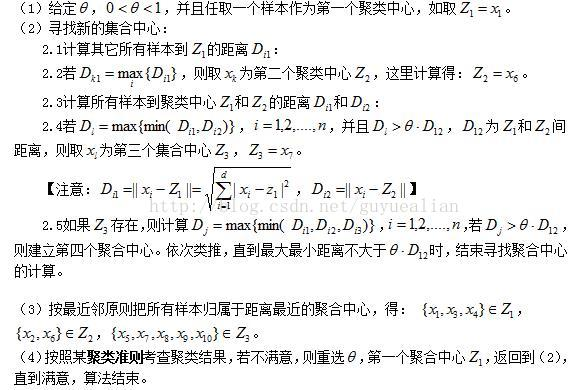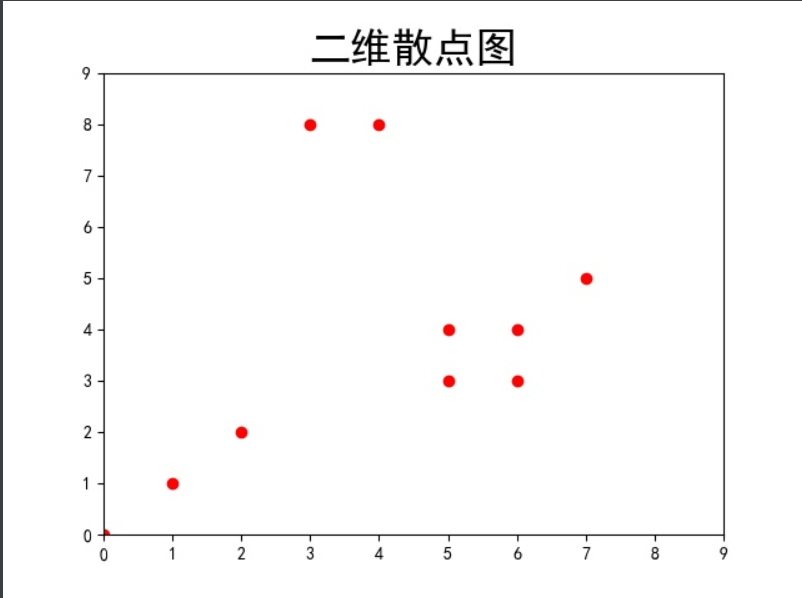最大最小距离算法基本思想
最大最小距离法是模式识别中一种基于试探的类聚算法,它以欧式距离为基础,取尽可能远的对象作为聚类中心。因此可以避免K-means法初值选取时可能出现的聚类种子过于临近的情况,它不仅能智能确定初试聚类种子的个数,而且提高了划分初试数据集的效率。 该算法以欧氏距离为基础,首先初始一个样本对象作为第1个聚类中心,再选择一个与第1个聚类中心最远的样本作为第2个聚类中心,然后确定其他的聚类中心,直到无新的聚类中心产生。最后将样本按最小距离原则归入最近的类。
最大最小距离聚类算法步骤如下:

实例:

代码:
# 最大最小距离算法的Python实现 # 数据集形式data=[[],[],...,[]] # 聚类结果形式result=[[[],[],...],[[],[],...],...] # 其中[]为一个模式样本,[[],[],...]为一个聚类 import math def start_cluster(data, t): zs = [data[0]] # 聚类中心集,选取第一个模式样本作为第一个聚类中心Z1 # 第2步:寻找Z2,并计算阈值T T = step2(data, t, zs) # 第3,4,5步,寻找所有的聚类中心 get_clusters(data, zs, T) # 按最近邻分类 result = classify(data, zs, T) return result # 分类 def classify(data, zs, T): result = [[] for i in range(len(zs))] for aData in data: min_distance = T index = 0 for i in range(len(zs)): temp_distance = get_distance(aData, zs[i]) if temp_distance < min_distance: min_distance = temp_distance index = i result[index].append(aData) return result # 寻找所有的聚类中心 def get_clusters(data, zs, T): max_min_distance = 0 index = 0 for i in range(len(data)): min_distance = [] for j in range(len(zs)): distance = get_distance(data[i], zs[j]) min_distance.append(distance) min_dis = min(dis for dis in min_distance) if min_dis > max_min_distance: max_min_distance = min_dis index = i if max_min_distance > T: zs.append(data[index]) # 迭代 get_clusters(data, zs, T) # 寻找Z2,并计算阈值T def step2(data, t, zs): distance = 0 index = 0 for i in range(len(data)): temp_distance = get_distance(data[i], zs[0]) if temp_distance > distance: distance = temp_distance index = i # 将Z2加入到聚类中心集中 zs.append(data[index]) # 计算阈值T T = t * distance return T # 计算两个模式样本之间的欧式距离 def get_distance(data1, data2): distance = 0 for i in range(len(data1)): distance += pow((data1[i]-data2[i]), 2) return math.sqrt(distance) if __name__=='__main__': data = [[0, 0], [3, 8], [1, 1], [2, 2], [5, 3], [4, 8], [6, 3], [5, 4], [6, 4], [7, 5]] t = 0.5 #比例因子 result = start_cluster(data, t) for i in range(len(result)): print("----------第" + str(i+1) + "个聚类----------") print(result[i])
结果:
----------第1个聚类---------- [[0, 0], [1, 1], [2, 2]] ----------第2个聚类---------- [[3, 8], [4, 8]] ----------第3个聚类---------- [[5, 3], [6, 3], [5, 4], [6, 4], [7, 5]]